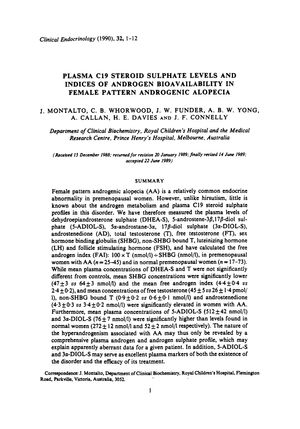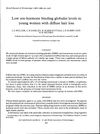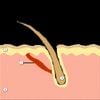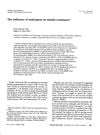Plasma C19 Steroid Sulfate Levels and Indices of Androgen Bioavailability in Female Pattern Androgenic Alopecia
January 1990
in “
Clinical Endocrinology
”
androgenic alopecia dehydroepiandrosterone sulphate DHEA-S total testosterone T sex hormone binding globulin SHBG free androgen index FAI free testosterone non-SHBG bound T androstenedione 5-androstene-3β,17β-diol sulphate 5-ADIOL-S 5α-androstane-3α,17β-diol sulphate 3α-DIOL-S androgenic alopecia DHEA-S testosterone SHBG FAI free testosterone androstenedione 5-ADIOL-S 3α-DIOL-S

TLDR Women with female pattern hair loss have higher levels of certain androgens, suggesting increased androgen exposure to hair follicles.
In a 1990 study, researchers examined androgen metabolism in premenopausal women with female pattern androgenic alopecia (AA) compared to normal controls, although the exact number of participants was not specified. They found no significant difference in dehydroepiandrosterone sulphate (DHEA-S) and total testosterone (T) levels between the two groups. However, sex hormone binding globulin (SHBG) concentrations were significantly lower, and the free androgen index (FAI), free testosterone, non-SHBG bound T, and androstenedione levels were significantly higher in the AA group. Additionally, plasma concentrations of 5-androstene-3β,17β-diol sulphate (5-ADIOL-S) and 5α-androstane-3α,17β-diol sulphate (3α-DIOL-S) were significantly elevated in women with AA. These findings suggest that 5-ADIOL-S and 3α-DIOL-S could be useful markers for AA and its treatment, indicating increased androgen availability to hair follicles in women with AA.







